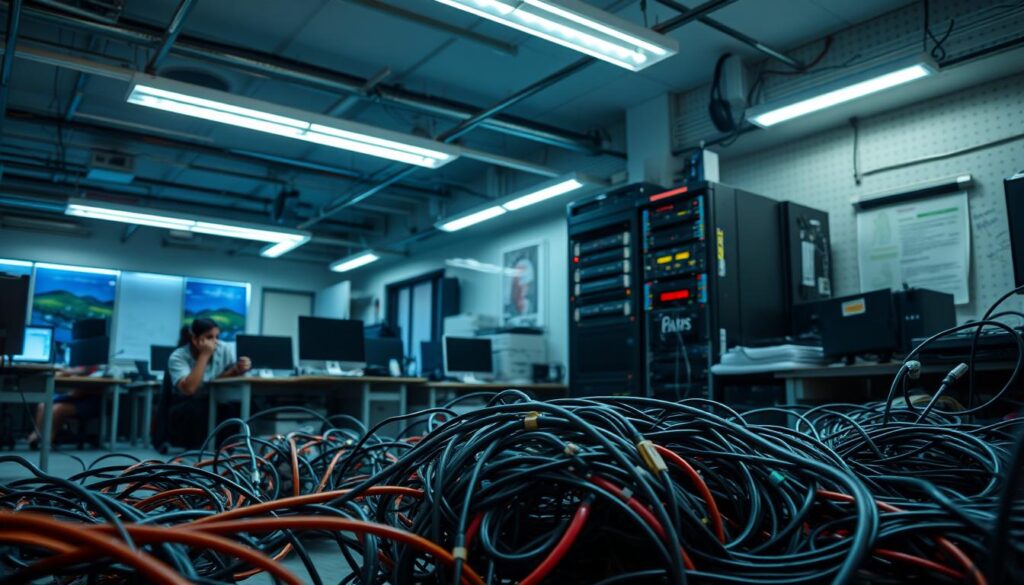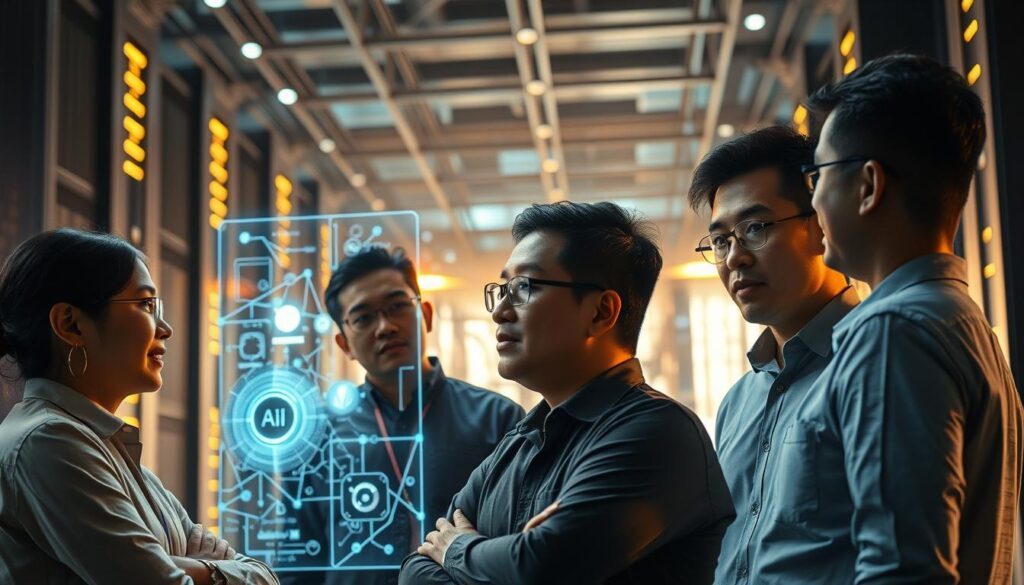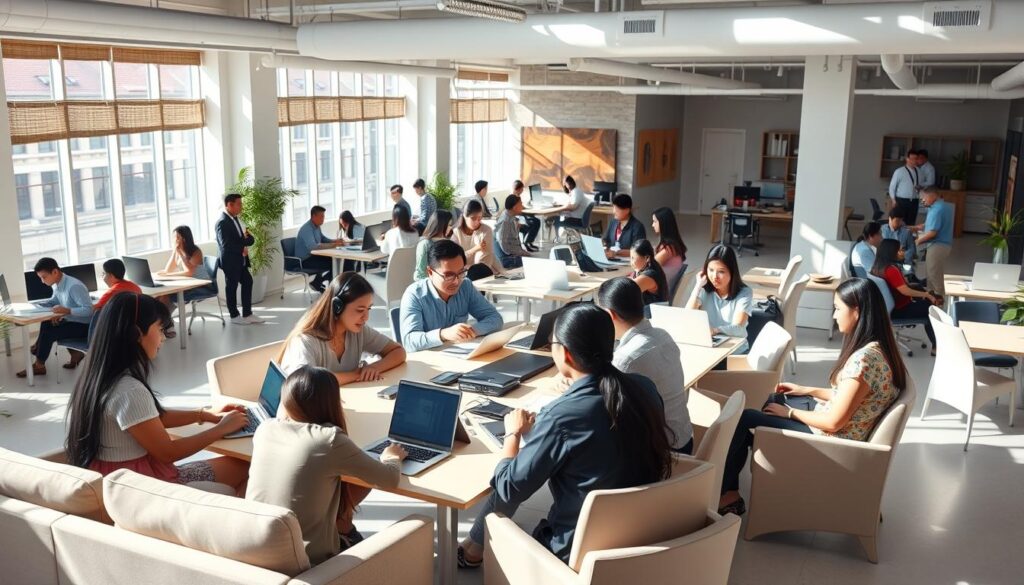As we stand at the edge of a technological revolution, a big question arises. Will artificial intelligence change how we work, or will it take away our jobs? The use of AI in work is more than just a boost; it’s a big change that will alter job scenes, mainly in Southeast Asia. By 2030, about 15% of jobs might be lost to automation, making companies balance efficiency and jobs.
The AI future of work is changing fast. Companies are learning to use new tech to boost productivity and create new jobs. But, there are big challenges too. In this article, we’ll look into AI’s role in work, its benefits and hurdles, and how to get ready for a future where humans and AI work together.
It’s key for businesses and workers to understand this change, as job needs and leadership styles evolve in an AI world. We’ll see how to use AI’s power, focusing on the need for proactive steps to face risks and grab chances in this new tech world.
Key Takeaways
- The AI future of work presents both challenges and opportunities, with 15% of jobs projected to be displaced by 2030.
- Effective implementation of AI in the workplace could enhance efficiency and productivity significantly.
- Understanding the implications of AI is essential for developing strategic leadership within organizations.
- Emerging technologies, including low-code applications and AI-driven automation, are set to reshape traditional job roles.
- Preparing for job transitions and upskilling will be crucial to mitigating the effects of job displacement.
Understanding the AI Revolution in the Workplace
AI technologies are changing how businesses work. They make things more efficient by automating tasks and making better decisions. As more companies see AI’s value, they’re starting to use it more. This section looks at what AI means in today’s offices and the main technologies behind this change.
What is AI in the Workplace?
AI in the workplace means using artificial intelligence to do tasks that need human smarts. It includes automating repetitive tasks, analyzing big data, and helping with tough decisions. Using AI can make businesses more productive, with a potential gain of ₱250 trillion. Over 90 percent of companies plan to spend more on AI in the next three years, showing they’re committed to these new technologies.
Key Technologies Shaping AI
Several key AI technologies are driving this workplace change:
- Machine Learning: This part of AI lets systems get better over time by learning from data. It’s key for keeping up with job trends and staying competitive.
- Natural Language Processing (NLP): NLP lets machines understand and respond to human language. It’s used a lot in customer service to make communication smoother.
- Robotics: AI-powered robots help with tasks, making things faster and more accurate in places like factories and warehouses.
Companies like Ice Innovations are at the forefront of using these technologies in areas like healthcare, finance, and retail. As AI gets better, businesses need to keep up with changing job expectations and roles.
The Impact of AI on Job Roles
The job world is changing fast with AI’s rise. Businesses using AI are changing old job roles. This change makes work better and creates new AI jobs. Workers can now focus on important tasks, not just simple ones.
How AI is Transforming Traditional Roles
AI makes jobs better by automating simple tasks. This lets workers do more important things. For example, AI chatbots help in customer service, so humans can solve harder problems.
In healthcare, AI helps diagnose diseases quickly and accurately. This improves patient care.
New Job Categories Emerging from AI
New jobs are coming because of AI. Jobs like AI Trainers, Data Scientists, and Ethics Specialists are needed. The World Economic Forum says 85 million jobs might be lost, but 97 million new ones will be created.
Companies are investing in training to help workers learn about AI. This is key for the future of jobs.

| Industry | Job Displacement (millions) | New Job Creation (millions) |
|---|---|---|
| Manufacturing | 20 | 15 |
| Healthcare | 5 | 10 |
| Finance | 10 | 15 |
| Education | 5 | 20 |
AI is being used in many areas to make things better. It helps grow the economy and creates new jobs. As people get used to these changes, using AI will be key for the future workforce.
AI and Productivity: A Growing Relationship
AI technology is changing how we work, making things more efficient. As more businesses use automation, they can do things faster and better. This is true in many places, like Southeast Asia, where companies quickly start using AI.
It’s important to understand how these changes affect different industries. As the world changes fast, businesses must adapt to keep up.
Enhancing Efficiency Through Automation
AI can do routine tasks, freeing up people to work on creative projects. Many companies say they’re making more and spending less after using AI. For example, a study found that places using AI hire more for AI jobs but less for other roles.
This shows how work is changing as companies look to be more efficient. The digital transformation workforce is growing, and skills are needed to keep up with these changes.
Real-World Examples from Southeast Asia
In Southeast Asia, AI is making a big difference. In factories, robots help with assembly and checking quality, making things better. In online shopping, AI helps by suggesting products and improving delivery.
Studies show that areas using more automation see more jobs, but in different roles. As industries change, the role of AI in the workforce becomes more important. The path to a more automated workplace has its challenges, but it also brings new opportunities for growth and innovation.
Challenges of Implementing AI in Businesses
Companies face many hurdles when trying to use AI. These include money issues, technical problems, and resistance from employees. It’s key to overcome these obstacles to successfully add AI to a business.
Identifying Potential Barriers
AI brings many challenges for businesses. The biggest one is the cost of starting up with AI technology. Many companies have small budgets, making it hard to afford AI.
Another big problem is the complexity of AI systems. Companies often don’t have the right skills to use these advanced tools. Also, some employees might be scared of losing their jobs or not knowing how to use new systems.
Addressing Skills Gaps in the Workforce
There’s a big gap in skills when it comes to AI. Many workers don’t know how to use AI tools well. This limits the benefits of AI in the workplace.
Companies need to invest in training. Teaching employees about AI can help them feel more comfortable with change. Programs like coding boot camps and AI literacy courses can help bridge the skill gap.

Preparing for AI-Driven Job Displacements
The fast growth of artificial intelligence in Southeast Asia worries many about job losses. Automation is getting better, and some jobs are at risk. Jobs in manufacturing, transportation, and retail are most likely to be automated. Knowing this helps us plan for workers to adapt and succeed in the new world.
Recognizing At-Risk Jobs in Asia
Experts say up to 375 million workers might need new skills by 2030 because of AI and automation. These changes are happening fast, making many jobs outdated, mainly those that need manual labor. Recognizing this is the first step to get ready for the job market changes.
Strategies for Workforce Transition
There are ways to help workers deal with these changes. Here are some strategies:
- Implement Reskilling Programs: Training in data analysis, programming, and machine learning can help workers move to new areas.
- Create Clear Career Pathways: Having clear paths in companies helps employees know how to move to new roles with new tech.
- Foster a Culture of Continuous Learning: Encouraging learning throughout life keeps workers ready for new job needs.
- Leverage AI in Training: Using AI in training makes it more personal and effective for each worker.
By starting these efforts, companies can help their workers through the changes AI brings. This ensures workers are ready for the future job roles that technology will create.
AI in Recruitment: Changing Hiring Practices
AI is changing how companies hire people. It brings new ways to find and hire the best candidates. This makes hiring faster and better.
Streamlining the Recruitment Process
More than 55% of companies use AI for hiring. It helps HR teams sort through many applications quickly. AI looks for key words in resumes, making it easier to find the right people.
AI also helps avoid unfair hiring biases. It ignores things like gender and race. This makes hiring fairer. Plus, AI helps find the best ways to reach job seekers.
Case Studies of Successful Implementations
Companies like Unilever and L’Oréal use AI for hiring. Unilever’s tool checks how well candidates speak, with 90% accuracy. L’Oréal’s tool analyzes answers, finding the right candidates 85% of the time.
AI saves time and makes hiring better. It can cut recruiter time by 30% and answer 80% of initial questions. This lets HR teams focus on what really matters.
Enhancing Collaboration Between Humans and AI
Companies are now seeing the value of working better with AI. Trust in AI is key for success. When people trust AI, they use it better, making work more efficient.
It’s important to tackle worries about AI, like how it works and if it’s fair. This helps build trust.
Building Trust in AI Systems
Trust in AI comes from being clear about how it works. AI uses data to learn, so knowing about data is crucial. Workers need to understand different types of data to make sense of AI’s findings.
As AI becomes part of work, training is vital. It helps workers use AI well.
How AI Can Augment Human Skills
AI can make people better at their jobs in many ways. It does data work and automates simple tasks. This lets people think more about big ideas and creativity.
In healthcare, AI helps doctors make quick and accurate diagnoses. In finance, AI changes how companies manage risks with smart algorithms.
AI is creating new jobs, like AI trainers and machine learning engineers. Workers need to keep learning to keep up. Sharing AI insights helps everyone make better decisions. Companies that adapt to AI can be more innovative and efficient.
The Role of Leadership in AI Integration
Effective AI integration in businesses depends a lot on leadership. Leaders guide their teams through the tech changes. They need skills in technology, managing change, and teamwork.
They must be open to change and help their teams adapt. This is key to overcoming AI’s challenges.
Essential Skills for Business Leaders
As AI changes work, leaders must learn new skills. Knowing technology helps them make smart AI choices. They also need to manage change well to keep teams happy and innovative.
It’s important to remember that AI can’t replace human connection. Emotional intelligence is still crucial.
Inspiring Team Adaptation to AI Changes
Leaders must support their teams through AI changes. By updating job designs and workflows, they can make things better with AI. This boosts productivity.
Using AI ethically builds trust with employees and customers. Studies show 62% of customers prefer ethical businesses. A team working together can successfully adopt AI, leading to a bright future.

Policy and Ethical Considerations in AI
AI in the workplace needs careful thought for ethical and fair use. AI regulations are key to handle data privacy, bias, and transparency. Southeast Asia is working on rules that match the fast pace of tech and work changes.
Regulatory Frameworks in Southeast Asia
AI governance in Southeast Asia comes with unique challenges. New rules aim to protect workers while encouraging new ideas. This area needs rules that keep up with tech progress.
| Country | Current Regulatory Status | Key Challenges | Future Directions |
|---|---|---|---|
| Philippines | Drafting AI regulations | Data privacy issues | Focus on inclusive growth |
| Singapore | Established AI Governance Framework | Balancing innovation and ethics | Enhancing international cooperation |
| Malaysia | Building AI ethics guidelines | Awareness of bias | Promoting public trust |
| Indonesia | In early stages of AI regulation | Technological adoption disparities | Investing in technological education |
Ethical AI Use in the Workplace
Organizations must focus on ethical considerations for responsible AI use. AI tools for hiring and promotion should be checked for bias. This ensures fairness and keeps public trust.
It’s important to involve employees and stakeholders in AI decisions. As work changes, we need to update labor laws. Ideas like Universal Basic Income and flexible work are being looked at to help with job changes due to automation.
The Future Work Environment: Blended Work Models
The workplace is changing fast, thanks to blended work models. These models mix traditional offices with remote work. They meet employee needs for flexibility and use AI to boost productivity and teamwork.
Companies are finding a balance between tech and giving employees freedom. This balance is key to success in the future.
Remote Work and AI Support
Remote work is now a big part of company plans, thanks to global changes. Companies use AI tools to help remote teams work better. These tools cut down on mistakes, make decisions faster, and let employees focus on important tasks.
AI helps with scheduling, managing tasks, and talking to each other. It makes work flow smoothly, no matter where team members are.
Flexible Work Arrangements Powered by AI
AI also helps make work flexible for each person. It uses smart tech to help companies work better and keep employees happy. For example, AI can manage how spaces are used, making sure resources are used well.
This move towards blended work models makes work better and keeps companies ready for change.

Upskilling and Continuous Learning for Employees
Artificial intelligence is changing the way we work. It’s important for both employees and companies to embrace upskilling. Lifelong learning helps us stay ahead in this fast-changing world. It lets us adapt and grow in our careers.
Importance of Lifelong Learning
AI is advancing quickly, and employees need to keep learning. New jobs will pop up in healthcare, finance, and tech by 2030. Upskilling is cheaper than hiring new people, saving companies money.
Reskilling can boost productivity by 6-12%. About 75% of reskilling efforts pay off, showing the value of learning. This makes a strong case for companies to encourage learning.
Asian Companies Leading the Way in Upskilling
Asian companies are leading in upskilling. For example, Bank of America’s “The Academy” helps over 40,000 employees every year. Verizon is spending ₱2.5 billion to prepare 500,000 people for future jobs by 2030.
Accenture invested nearly ₱56 billion in 2021 to reskill 700,000 employees. These efforts show how crucial it is for companies to support AI education and adaptability.
A Brighter Future: Embracing AI in the Workplace
The future of AI in business looks bright, thanks to Southeast Asia’s adoption of new AI solutions. Companies are using AI to make their work more efficient and productive. This helps grow the economy and creates new job opportunities that need advanced skills.
Positive Examples of AI Adoption
Companies like FedEx have seen big benefits from AI. They’ve cut their hiring time to under 10 minutes with conversational AI. The healthcare sector is also set to gain nearly 1 million jobs, thanks to AI. This will lead to more job openings for AI experts.
The Road Ahead for Southeast Asian Businesses
Businesses need to plan carefully for the AI future. Automation and AI will change many jobs, creating a skills gap. To stay ahead, workers and companies must keep learning and training.
Investing in employee development is key. It helps businesses make better decisions and keeps workers happy and engaged.

